[ad_1]
Reusing greywater is one of the best things you can do to reduce water demands and become more sustainable and self-sufficient, especially if you want to live off-grid.
To get you started, here’s what you need to know:
What Is Grey Water?
Grey water (also greywater, gray water, or graywater) is a type of wastewater that contains fewer contaminants than black water, so it is easier to treat and reuse.
The legal definition of grey water varies from place to place but is usually defined as water coming from sinks, showers, bathtubs, and washing machines.
For more on the legal definition of grey water, read: Grey Water vs. Black Water
How Much Grey Water Do We Produce?
Depending on which source you go by, the average American uses anywhere from 25 to 156 gallons of water per day. Of this water, about 25% goes towards flushing toilets.
The rest could be classified as grey water. This is a considerable amount of water that could be reused.
Water Use Breakdown:
- One toilet flush: 3 gallons
- Full bathtub: 36 gallons
- 10-minute shower: 20 gallons
- Washing machine load: 15 gallons
- Dishwasher load: 4 to 10 gallons
- Hygiene: 2.5 gallons
- Drinking water: 1 gallon
Is Grey Water Dangerous?
Grey water can carry pathogens, including bacteria and viruses, and chemicals from detergents, soap, and cleaning products.
However, the contamination levels are very low and do not usually pose a health threat. Thus, even untreated greywater can safely be used for things where potable water isn’t needed, such as irrigating lawns or flushing toilets.
Can You Drink Grey Water?
Some advanced treatment systems can make grey water safe to drink. The drinking water in many municipalities actually comes from treated sewage water.
This treatment technology is usually out of reach for most households, so grey water is only used for nonpotable use.
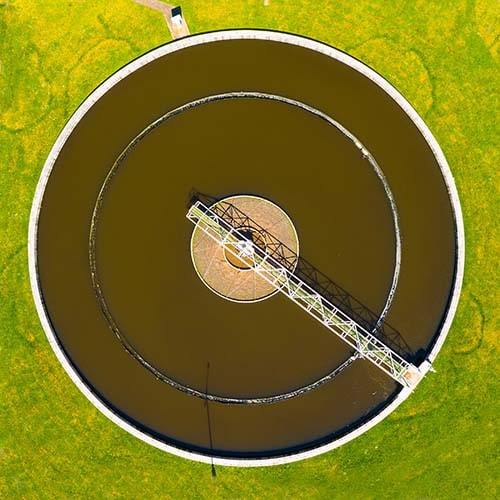
Why Reuse Grey Water?
Drought is becoming an increasingly big problem in many parts of the world. Grey water recycling and reuse can help reduce the strain on public water supplies.
It also reduces the amount of sewage sent to local treatment plants. Further, grey water can contain nutrients beneficial to plants for irrigation.
Grey Water Laws
There is no countrywide law or standard for grey water reuse in the USA.
Each state has laws about how grey water can be reused. The definition of what counts as grey water also varies by state. Most states require grey water to be plumbed separately from potable water, which must be labeled as nonpotable.
Many states define laundry and sink waste as blackwater and do not allow it to be reused in grey water systems.
For example:
- Maine: Grey water can be disposed of in fields but needs to be treated with an effluent filter. You will also need a permit. Laundry waste and hot tub water is not considered grey water and must be treated with a conventional sewage system. Read more about Maine off grid laws.
- Alabama: The laws are strict and require you to filter and disinfect grey water before reusing it, even for flushing toilets. Read more about Alabama off grid laws.
- California: Recycling washing machine grey water is legal, but only if the water stays on the property, is used outdoors, is discharged under a 2″ cover, and has a way to direct flow back to the sewer system (such as a 3-way valve). Grey water cannot be used to irrigate crops where the edible portion touches the soil. Read more about California off grid laws.
- Ohio: The state defines greywater as “wastewater discharged from lavatories, bathtubs, showers, clothes washers, and laundry sinks that does not contain food wastes or urine or fecal matter.” Using greywater for irrigation is legal, but you must first have your soil inspected and get a permit. Read more about Ohio off grid laws.
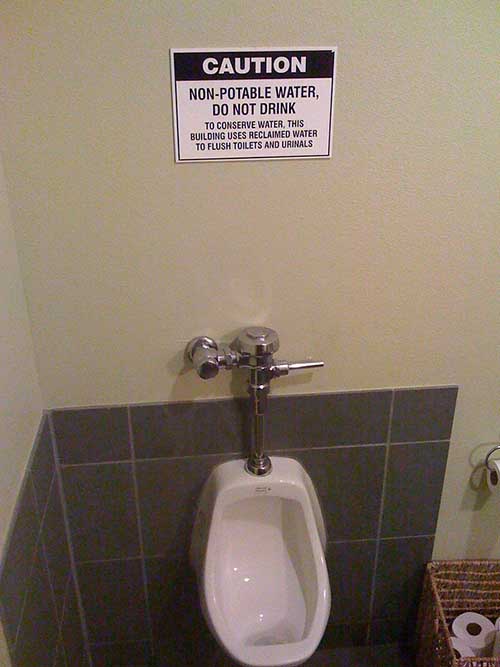
Uses for Grey Water
There are many other potential uses for grey water, the most common of which are irrigation and flushing toilets. How you can use grey water ultimately depends on the condition of the grey water.
Some types of grey water are “cleaner” and thus better suited for specific purposes. For example, shower and bath grey water typically have lower contaminant loads than grey water from kitchen sinks or laundry machines.
You can improve the quality of your grey water by avoiding harsh chemical cleaners, using low- or no-sodium laundry detergents, and installing strainers and grease filters in kitchen sink grey water systems.
Grey water also shouldn’t be allowed to sit for more than 24 hours as it can start to smell.
Irrigation
Grey water can generally be used for irrigating crops, gardens, and lawns with little or no treatment. Even grey water from sinks can often be used as the food particles can nourish plants. These guidelines should be used when irrigating with grey water.
- Use grey water slightly below the soil surface.
- Do not spray grey water on leaves, twigs, or stems of plants.
- Do not use sprinklers to irrigate with grey water. It can cause pathogens in the water to become airborne.
- Control the grey water discharge to prevent runoff and pooling.
- Only use biodegradable soaps. Don’t use boron products for cleaning as it is toxic to plants.
- Periodically do a soil test for salinity and boron.
- Unless it is treated, do not use grey water to irrigate edible crops which will come in contact with the grey water.
Flushing toilets and other indoor uses
The average toilet uses 2.2 gallons of potable water per flush. Most people flush 5x per day. Using grey water to flush toilets instead of potable water can save 11 gallons of water per person daily.
Unfortunately, many states still don’t allow grey water to be used indoors for things like flushing toilets legally. You may be required to install a complicated treatment system even when permitted.
There are simple systems for using grey water to flush toilets where it is allowed. For example, the “Sink Positive” design has a sink that drains directly into the toilet top tank.
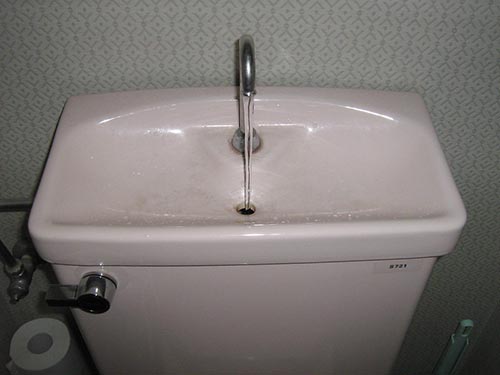
Grey Water Reuse Systems
There are many different ways to collect and reuse grey water. The systems can be straightforward (such as a bucket system) or incredibly advanced with multiple stages of treatment and filtration. Below are some of the most straightforward grey water reuse systems.
You can find a great chart on the types of grey water systems here (PDF).
Buckets
The easiest way to collect grey water is to put a bucket under a shower or sink drain. The water can then be dumped into toilet top tanks for flushing or carried outside and poured onto the ground for irrigation.
Laundry-to-Landscape
Reusing laundry machine grey water is typically very easy because you can divert it without having to alter your home plumbing system. You redirect the laundry drain hose so it goes outside.
It’s also easy to install 3-way valves, which let you easily switch from discharging outside to the sewer system.
Get a free book on laundry-to-landscape design here.
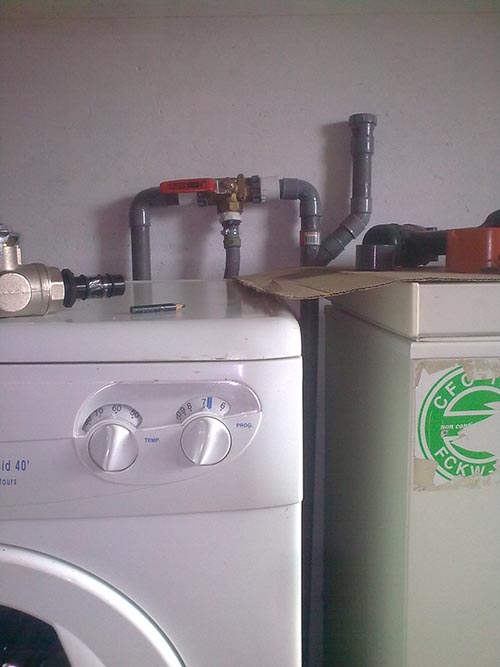
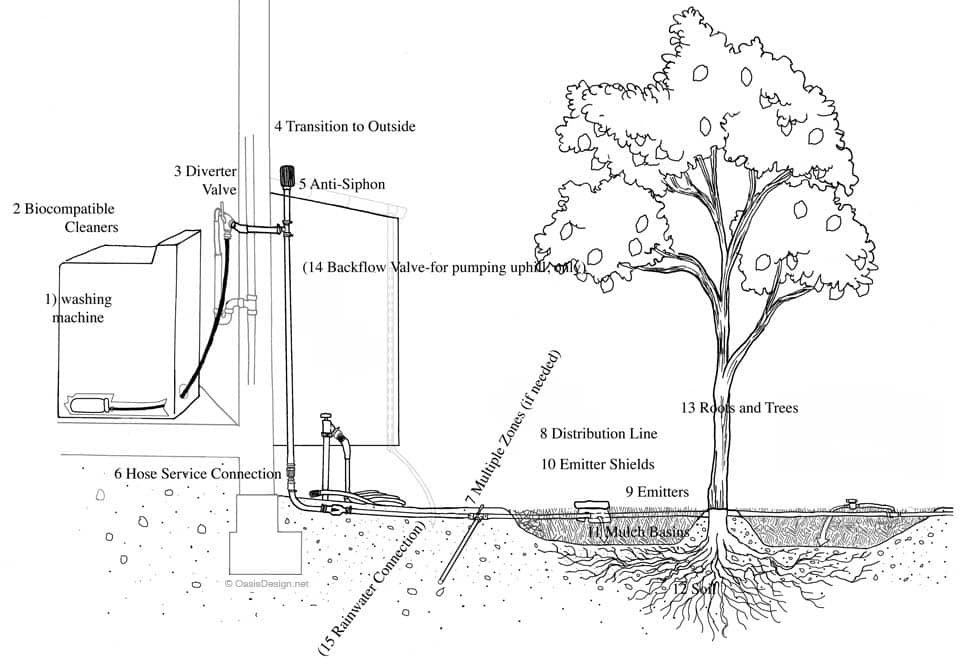
Gravity Grey Water System
These systems are particularly good for recycling shower and bath grey water.
The drains divert from the sewer system and go directly to the yard. Or, depending on local regulations and needs, the water can go through a filtration system and into a storage tank before being released into the yard. If your yard is located uphill, you will need a pumped system.
Pumped Grey Water Systems
Pumped grey water systems typically divert grey water into a storage container (such as a large barrel). A pump in the container then moves the water through irrigation lines.
Branched Drain Grey Water Systems
These systems also rely on gravity to move grey water. However, the drainage pipes are divided, so the water flows to a different mulched basin.
For example, one outlet can take grey water to tree roots whereas another can go to the garden. The pipes must slope downwards at 2% (or ¼”) for every 12 inches traveled horizontally.
You’ll need to dig up a large portion of your yard to install a branched drain system but once installed, these systems are very easy to operate and maintain.
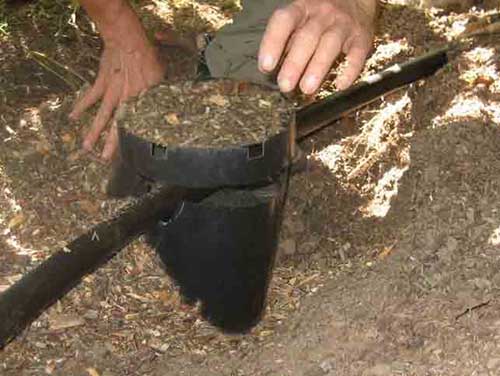
Laundry Drum/Surge Tank Grey Water System
Instead of diverting laundry grey water directly outside, it can be diverted into a storage drum (called a surge tank). The drum needs to have an outlet at the bottom where you can attach a hose. The system is easy and cheap to install, but you’ll have to empty the drum manually.
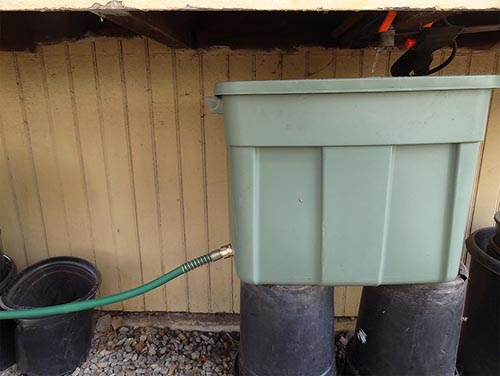
Kitchen Sink Grey Water Systems
Kitchen sink wastewater often contains high grease, food particles, and other contaminants. To use it, you may need to install a filter and/or a grease trap.
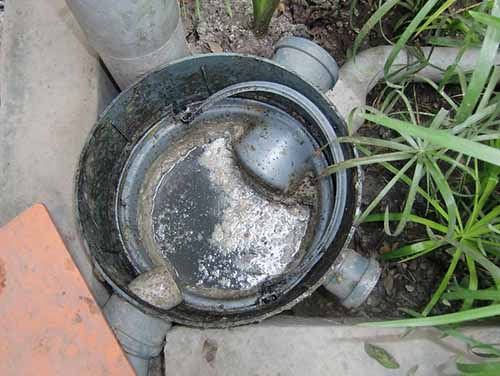
Grey Water Treatment Options
Settling Tanks
With these treatment systems, grey water first goes to a tank. The solid particles will sink to the bottom, and grease floats on the top, allowing them to be removed. Another benefit is that hot water can cool in the settling tank before it is reused.
There are even special grey water septic tanks that can be used for settling. These are separate from septic tanks used for toilet waste and other black water.
One potential problem with settling tanks is that they can clog easily. They need to be regularly pumped out. The grey water inside the settling tank does not contain much oxygen, so it isn’t ideal for irrigation unless you install an aerator.
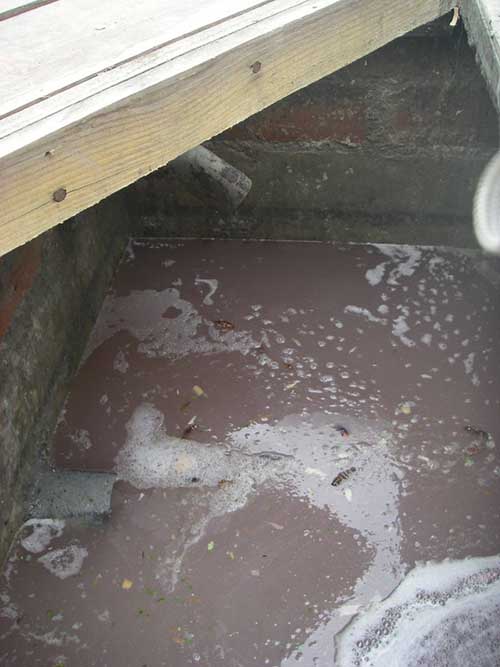
Disinfection
Many states require you to disinfect grey water before reusing it indoors (even for flushing toilets!). The most common ways to disinfect grey water are chlorine, iodine, and UV treatment.
Filters
A grey water filter can be as simple as a strainer put underneath a laundry drainage hose or a cloth bag at the end of a drain pipe.
There are also much more advanced grey water filters available, such as ones that use activated charcoal, ceramic or multi-media filters. It’s also possible to create your own filtration system using layers of sand and gravel.
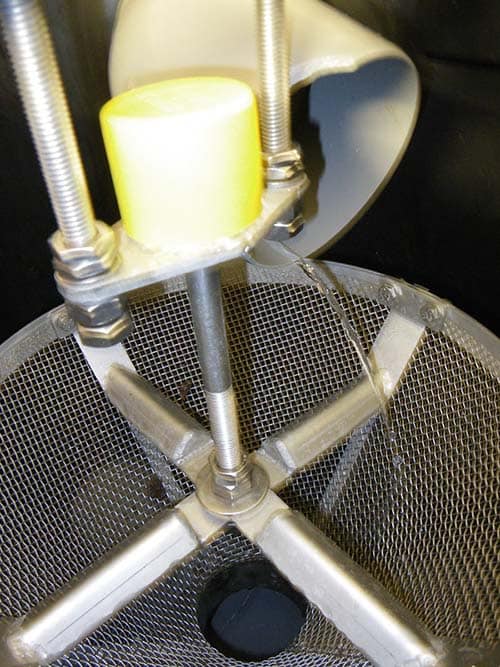
Constructed Wetlands
Constructed wetlands are used in situations where you have more greywater than you can use and need a safe way to dispose of it (but don’t want to put it in your septic tank or the municipal sewer system).
They are especially useful if you live near a lake, stream, or other waterways. You generally cannot discharge grey water into these waterways because it can cause pollution. The large amounts of nitrates and phosphates in grey water can cause algae blooms in waterways.
The wetland acts as a natural purifier, absorbing contaminants from the grey water so they don’t get into nearby waters. It’s also possible to put particles from grey water filters into constructed wetlands.
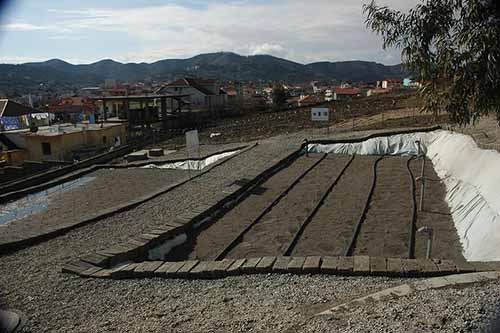
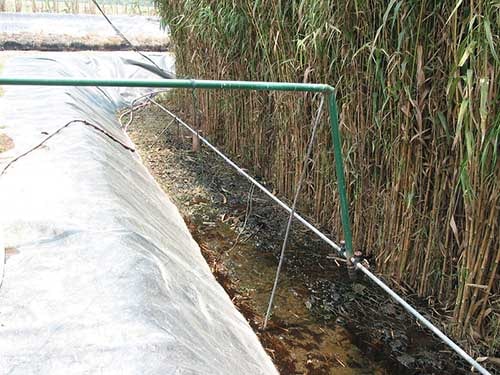
“Recycled grey water” (CC BY-SA 2.0) by rubenerd,
“Don’t Drink the Water” (CC BY-NC-ND 2.0) by Tom Carmony,
“This is what I call grey water usage” (CC BY-SA 2.0) by Gavin Anderson,
“Constructed wetland” (CC BY 2.0) by Sustainable sanitation,
“Inlet area of another constructed wetlan” (CC BY 2.0) by Sustainable sanitation,
“3-way valve to divert the laundry greywa” (CC BY 2.0) by Sustainable sanitation,
“Grease trap for greywater” (CC BY 2.0) by Sustainable sanitation,
“”HUBER Turny” preceding screen for greyw” (CC BY 2.0) by Sustainable sanitation,
“Greywater settling tank and grease trap” (CC BY 2.0) by Sustainable sanitation,
“Bonsallo Ave Urban Garden Greywater” (CC BY 2.0) by craigdietrich,
“Settling tank for kitchen greywater” (CC BY 2.0) by Sustainable sanitation,
“Grey water filtration” (Public Domain) by karenblakeman
[ad_2]
Source link
